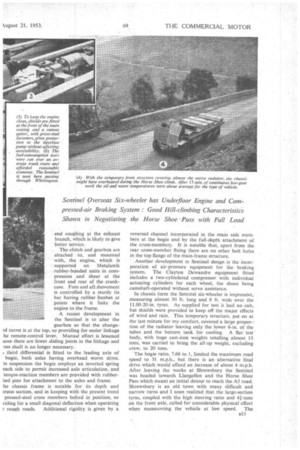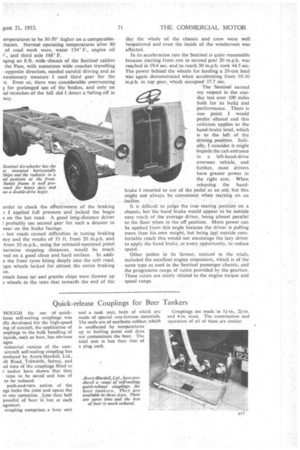Best of Both Worlds
Page 46

Page 47

Page 48

Page 51

If you've noticed an error in this article please click here to report it so we can fix it.
By Laurence J. Cotton, M.I.R.T.E.
THE virtues of full-forward and normal control chassis are combined in the Sentinel overseas sixwheeler, which whilst affording the exceptional frame and body length of a cab-over-engine design,. has a spacious driving compartment, well divorced from the amidships-mounted engine. In every respect the Sentinel makes for safe and comfortable long-distance driving. The low noise level, and the roominess, of the cab lessen fatigue, and the even distribution of weight afforded by a centrally mounted engine in conjunction with the compressed-air braking system contributes towards safety.
The six-wheeled chassis tested, was one of a batch awaiting shipment to Turkey where they are to be equipped with tanker bodies for operation by an oil company. The regulations governing fuel-tanker operation in Turkey are more pliable than those in force in this country which demands that the engine and exhaust system should be mounted forward and separated from the tank by a fire-proof bulkhead.
As there is no fire risk from an oil engine, or danger of exhaust flame,.the only precaution taken in the case of the Sentinel, when on fuel tanker service, is to provide an asbestos shield above the exhaust manifold and silencer, and above the frame to cover the engine.
The Sentinel 9.12-litre horizontal six-cylindered engine is suspended below frame level behind the cab. It has the direct-injection system of combustion and develops 120 b.h.p. at 1,800 r.p.m. and 375 lb./ft. torque at 1,100.r.p.m. It is so disposed in the chassis as to come within the width of the chassis with the crankshaft offset in relation to the frame centre line.
The timing gear is at the front, a bevel drive being st2
provided for the fuel-injection pump which is carried transversely at t h e front where it is more accessible for maintenance.
I have often advocated that a shield should be fitted at the front to raise the operating temperature of the underfloor engine and one is provided in the Sentinel where it also serves to keep dirt and water from the unit. A canvas gaiter, secured by press-stud fasteners, shields the injection pump which is thus kept protected without impairing free access to it.
In the arrangement of auxiliaries, the starter motor is mounted on top of the crankcase but can be reached from below the body should it fail in service. The Clayton Dewandre compressor is attached to the engine having a belt drive from the front of the crankshaft. An auxiliary shaft extends forward to operate the fan and dynamo. Unlike the former Sentinel overseas chassis the radiator is mounted with its base level with the frame.
Air filtration is by a combined centrifuge-type precleaner and oil-bath unit which is attached outside the frame behind the engine, being connected to the induction manifold by a flexible hose. The flexible metallic pipe normally used between the engine and silencer on contemporary chassis is replaced by a ball end coupling at the exhaust branch, which is likely to give better service.
The clutch and gearbox are attached to, and mounted with, the engine, which is supported on Metalastik rubber-bonded units in compression and shear at the front and rear of the crankcase. Fore and aft thovernent is controlled by a sturdy tie bar having rubber ibushes at points where it links the engine to the frame.
A recent development in the Sentinel is to alter the gearbox so that the change.1d turret is at the top, so providing for easier linkage he remote-control lever. Manual effort is lessened ause there are fewer sliding joints in the linkage and -oss shaft is no longer necessary.
third differential is fitted to the leading axle of bogie, both axles having overhead worm drive. ts suspension the bogie employs an inverted spring each side to permit increased axle articulation, and torque-reaction members are provided with rubberbed pins for attachment to the axles and frame.
he chassis frame is notable for its depth and erous section, and in keeping with the present trend pressed-steel cross members bolted in position, so Ming for a small diagonal deflection when operating
r rough roads. Additional rigidity is given by a
reversed channel incorporated in the main side members at the bogie and by the full-depth attachment of the cross-members. It is notable that, apart from the rear cross-member fixing there are no other bolt holes in the top flange of the main-frame structure.
Another development in Sentinel design is the incorporation of air-pressure equipment for the braking system. The Clayton Dewandre equipment fitted includes a two-cylindered compressor with individual actuating cylinders for each wheel, the shoes being camshaft-operated without servo assistance.
In chassis form the Sentinel six-wheeler is impressive, measuring almost 30 ft. long and 8 ft. wide over the 11.00-20-in. tyres. As supplied for test it had no cab, but shields were provided to keep off the major effects of wind and rain. This temporary structure, put on at the last minute for my comfort, covered a large proportion of the radiator leaving only the lower 6-in, of the tubes and the bottom tank for cooling. A fiat test' body, with huge cast-iron weights totalling almost 13 tons, was carried to bring the all-up weight, excluding crew, to 20 tons.
The bogie ratio, 7.66 to 1, limited the maximum road speed to 31 m.p.h., but there is an alternative final drive which would afford an increase of about 4 m.p.h. After leaving the works at Shrewsbury the Sentinel was headed towards Llangollen and the Horse Shoe Pass which meant an initial detour to reach the A5 road. Shrewsbury is an old town with many difficult and narrow turns and I soon realized that the large-section tyres, coupled with thehigh steering ratio and 4i-tons on the front axle, called for considerable physical effort when manoeuvring the vehicle at low speed.
operation of a six-wheeled 20-ton vehicle in most overseas areas might not include such tortuous work. Since testing the chassis, wedges have been fitted to the front axle with resultant lightening of steering effort and these are now used as standard.
Once under way all engine noise was left behind, arid from previous 'experience with Sentinel goods chassis, I have always appreciated the spaciousness and comfort of the standard cab. Fan noise, however, was predominant. • • After driving 8 miles, the Sentinel fuel-supply system was changed over to a 3-gallon container fitted for the consumption trials, the first leg of an out-and-return course being staged from Mountford Bridge to Whitting. ton, a distance of 10 miles. This road is generally representative of trunk conditions, involving average main-road inclines up to 1 in 20 and a fair number of fast curves.
Driving at about 30 m.p.h. the measured distance was covered in just over 23 min. and 9.6 pints of fuel used. On the return run, which was perhaps more favourable, less fuel was required, but the time factor was about the same because of traffic hindrance. The overall consumption rate of 8.95 m.p.g. was yielded at 26.1 m.p.h. average speed. After calculating results, I thought of the petrol-engined lorry which, carrying half the load, would use as much fuel per mile as the-Sentinel.
B],t The climb to Chirk provided no obstacle, so I dr( on to Llangollen wending a course through the to for the onslaught of the Horse Shoe Pass in the coui of Denbigh. Climbing continuously on a I i-mile incl of 1 in 18 average gradient is no mean task, espeeia when there is a difficult approach with a I in 6 gradi, at the beginning. Such is the magnitude of the P2 that it brought the Sentinel down to the lowest ra just above the Britannia Inn where the gradient steepest.
Fortunately for the driver and observer, it was a 1 dry day—the ambient temperature reading being 780 as we negotiated the, Pass. The Sentinel toiled on just-over 17 mm. in second and third gears, but w the brake and accelerator pedals in direct line with • fan air stream I was forced to change feet on • accelerator pedal, such was the heat being dispen by the fan.
I dismounted quickly near the brow and took temperatures, the radiator water registering 188° sump oil 204° F. and the centre and rear axles 218° and 212° F. respectively. Considering the high day re; ing and the severity of the climb none of the tempe tures recorded was unusual, especially as the chassis I; new.
Under similar conditions, but with much lor: ambient readings, I have known engine and axle lut
emperatures to be 30-500 higher on a comparable;hassis. Normal operating temperatures after 80 of road work were, water 154° F., engine oil F., and third axle 168° F.
nging an 8-ft. wide chassis of the Sentinel calibre the Pass, with numerous wide coaches travelling : opposite direction, needed careful driving and as cautionary measure I used third gear for the It. Even so, there was considerable overrunning ; for prolonged use of the brakes, and only on tal stretches of the hill did I detect a falling-off in ncy.
order to check the effectiveness of the braking I applied full pressure and locked the bogie s on the hot road. A good long-distance driver probably use second gear for such a descent to year on the brake facings.
hot roads caused difficulties in testing braking ncy and the results of 33 ft. from 20 m.p.h. and from 30 m.p.h., using the solenoid-operated pistol termine stopping distances, would be much ved on a good clean and hard surface. In addio the front tyres biting deeply into the soft road, 3gie wheels locked for almost the entire braking cc.
much loose tar and granite chips were thrown up e wheels in the tests that towards the end of the
day the whole of the chassis and crew were well bespattered and even the inside of the windscreen was affected.
In its acceleration rate the Sentinel is quite reasonable because starting from rest in second gear 20 m.p.h. was reached in 19.4 sec. and to reach 30 m.p.h. took 44.5 sec. The power behind the wheels for hauling a 20-ton load was again demonstrated when accelerating from 10-30 m.p.h. in top gear, which occupied 37.7 sec.
The Sentinel earned my respect in the oneday test over 100 miles both for its build and performance. There is one point I would prefer altered and this criticism applies to the hand-brake level, which is to the left of the driving position. Initially, I consider it might impede the cab entrance in a left-hand-drive overseas vehicle, and further, most drivers have greater power in the right arm. When releasing the handbrake I resorted to use of the pedal as an aid, but this might not always be convenient when starting on an incline.. '
It is difficult to judge the true seating position on a chassis, but the hand brake would appear to be outside easy reach of the average driver, being almost parallel to the floor when in the off position. More power can be applied from this angle because the driver is pulling more than his own weight, but being just outside comfortable reach this would not encourage the lazy driver to apply the hand brake, at every opportunity, to reduce speed.
'Other points in its favour, noticed in the trials, included the excellent engine suspension, which is of the same type as used in the Sentinel passenger chassis; and the progressive range of ratios provided by the gearbox. These ratios are nicely related to the engine torque and speed range.




























































































